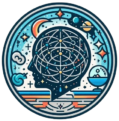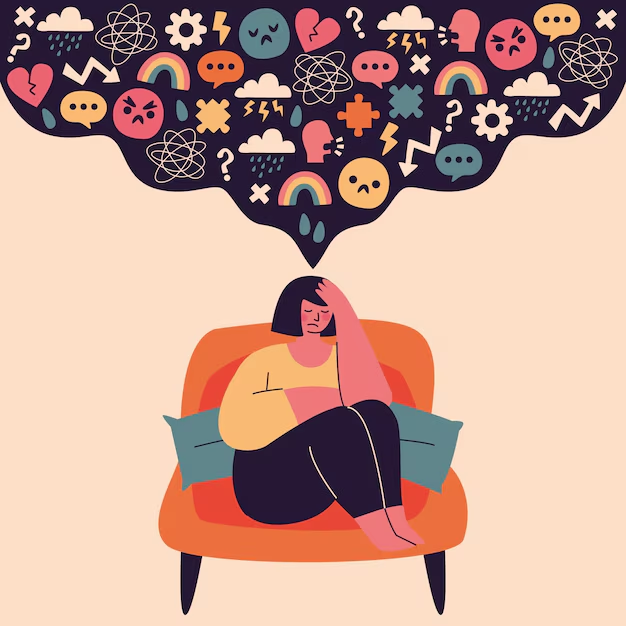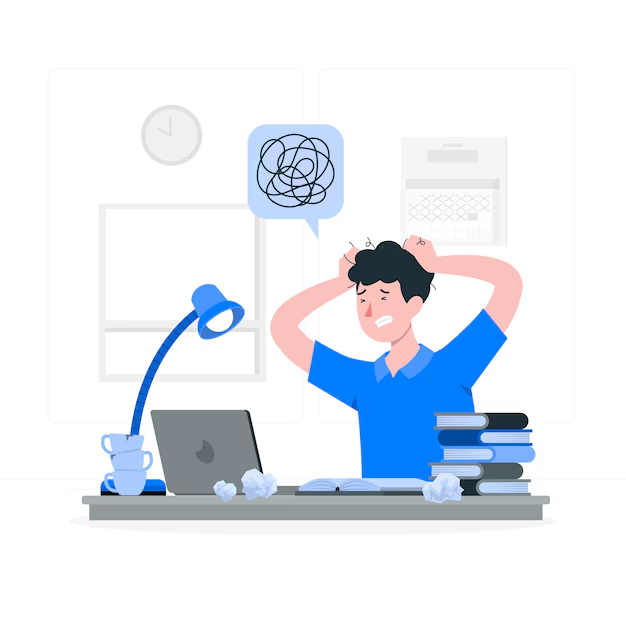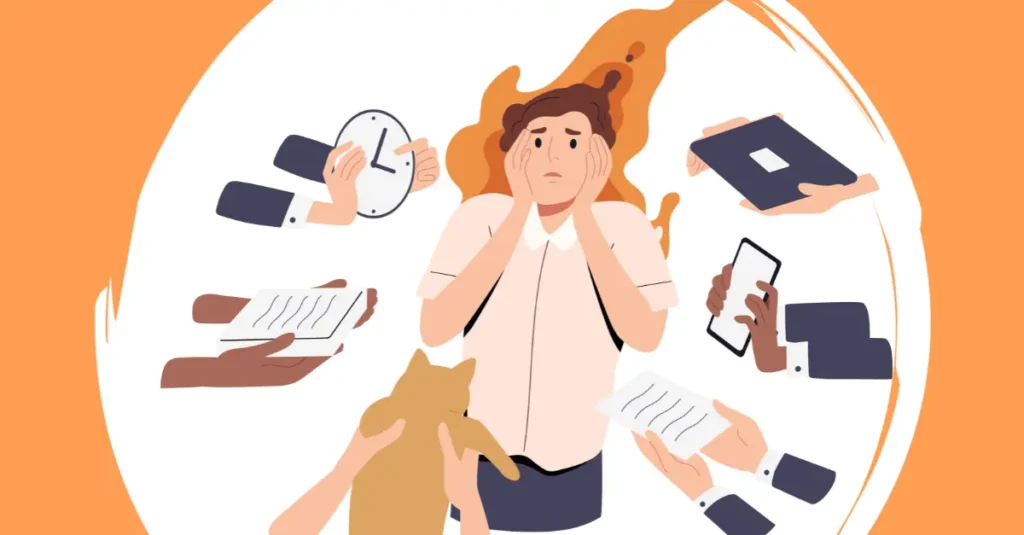Introduction
Modern Stress is an inevitable part of human life, but the forms it takes in today’s society are deeply tied to the structures of work and education. Far from being simply “too much to handle,” stress is a complex biopsychosocial response to pressures, expectations, and perceived demands. While moderate stress can motivate growth and productivity, chronic or toxic stress can impair mental health, erode resilience, and increase vulnerability to disorders (Lazarus & Folkman, 1984; McEwen, 2007).
In modern contexts, stress is particularly shaped by environments: the workplace and the school. These spaces are more than physical locations; they are ecosystems of expectations, interactions, and hierarchies. Understanding how these environments influence stress is crucial for developing healthier organizational cultures and educational systems.
Read More: What is Stress?
What Is Stress?
Stress can be defined as “a particular relationship between the person and the environment that is appraised by the person as taxing or exceeding his or her resources and endangering well-being” (Lazarus & Folkman, 1984, p. 19). It involves two core processes:
- Appraisal – the individual’s evaluation of whether a situation is threatening.
- Coping – the strategies employed to manage that situation.
Stress is not inherently harmful. The Yerkes-Dodson Law (1908) demonstrated that performance increases with arousal up to a point, after which it declines. This “inverted U” shows that a moderate level of stress can enhance focus, but overwhelming stress hinders functioning.

Biological Mechanisms of Stress
Stress triggers the hypothalamic-pituitary-adrenal (HPA) axis, releasing cortisol and adrenaline. While short-term activation prepares the body for “fight or flight,” chronic activation causes harm: weakened immunity, disrupted sleep, and increased risk of cardiovascular disease (McEwen, 2007). The brain also adapts to chronic stress, with structural changes in areas like the amygdala and hippocampus, influencing emotion regulation and memory (Lupien, McEwen, Gunnar, & Heim, 2009).

Thus, modern environments that generate prolonged stress contribute to long-term health risks.
Stress in the Workplace
Today’s workplace often valorizes busyness and constant availability. With globalization, digital connectivity, and remote work, boundaries between professional and personal life are increasingly blurred (Derks, van Duin, Tims, & Bakker, 2015). Employees may feel pressured to respond to emails late at night or sacrifice leisure for productivity, leading to “always-on” stress.
Sources of Workplace Stress
- Workload and deadlines – Excessive demands without adequate resources are strongly correlated with burnout (Maslach & Leiter, 2016).
- Job insecurity – In precarious economies, fear of unemployment contributes to chronic anxiety (Greenhalgh & Rosenblatt, 1984).
- Lack of control – Karasek’s (1979) demand-control model shows that jobs with high demands but low autonomy are particularly stressful.
- Toxic work cultures – Bullying, harassment, or lack of recognition erode psychological safety.
- Digital stressors – Constant notifications and surveillance software amplify pressure (Tarafdar, Cooper, & Stich, 2019).
Consequences
Workplace stress is linked to decreased productivity, higher absenteeism, and mental health issues such as depression and anxiety (Melchior, Caspi, Milne, Danese, Poulton, & Moffitt, 2007). Importantly, organizations also suffer economically from the costs of turnover and healthcare claims.
Stress in School Environments
For students, stress stems from balancing academic performance, extracurriculars, social relationships, and future uncertainties. High-stakes testing and competitive admissions systems intensify the pressure (Suldo, Shaunessy, & Hardesty, 2008).
Sources of Student Stress
- Performance expectations – Grades, standardized tests, and parental pressure drive achievement-related anxiety.
- Social dynamics – Bullying, exclusion, and peer comparison contribute to emotional stress (Espelage & Holt, 2013).
- Transition phases – Moving from high school to college or from college to the workforce brings uncertainty and identity struggles.
- Financial strain – Tuition costs and student debt exacerbate stress in higher education (Richardson, Elliott, & Roberts, 2017).
- Digital overload – Social media creates pressure to curate idealized selves, compounding stress levels (Twenge, 2019).
Consequences
Student stress manifests as academic burnout, sleep problems, depression, and disengagement (Schaufeli, Martínez, Pinto, Salanova, & Bakker, 2002). Left unaddressed, these issues can hinder both academic success and long-term well-being.
Comparing Work and School Stress
Although contexts differ, parallels exist: both involve hierarchical structures, performance evaluations, and social dynamics. Workplaces and schools both value productivity and output, sometimes at the expense of health. Students today are in many ways “pre-workers,” rehearsing the same stress patterns they will encounter in employment.
One distinction is agency: workers may have some autonomy in choosing jobs or negotiating conditions, while students often lack power in school systems. Conversely, student stress is often transitional, whereas workplace stress may span decades.
Coping with Modern Stress
Individual Coping Strategies for stress include:
- Problem-focused coping – addressing stressors directly, such as time management or seeking resources.
- Emotion-focused coping – regulating emotional responses through mindfulness, relaxation, or journaling.
- Avoidance coping – disengaging or distracting oneself, often maladaptive in the long run (Carver, Scheier, & Weintraub, 1989).
Mindfulness-based stress reduction (MBSR) programs have shown strong efficacy in reducing perceived stress in both workers and students (Kabat-Zinn, 2003).
Organizational and Institutional Interventions for stress include:
- Workplaces: flexible hours, mental health support, fair workloads, recognition systems, and employee autonomy.
- Schools: reducing high-stakes testing, promoting social-emotional learning (SEL), offering counseling, and teaching resilience skills.
Both contexts benefit from cultivating cultures where mental health is prioritized rather than stigmatized.
Technology
Digital tools enable remote work, online education, and access to resources. Yet they also amplify stress through constant notifications, blurred boundaries, and surveillance. For students, social media fosters comparison and “fear of missing out” (FOMO), while workers contend with “technostress” (Tarafdar et al., 2019). Balancing digital benefits with digital hygiene is crucial.
Shifting the narrative requires systemic change. At work, organizations must redefine success beyond output, embedding psychological safety and human dignity into their cultures. At schools, educators must embrace holistic development, nurturing curiosity, creativity, and socio-emotional growth rather than overemphasizing grades.
Public policy also plays a role, from labor laws that protect workers’ rights to education policies that reduce inequity. The COVID-19 pandemic highlighted the fragility of existing systems and the urgent need for resilient, humane environments.
Conclusion
Stress is not merely an individual weakness but a reflection of systemic pressures embedded in work and school environments. While moderate stress can motivate, chronic and unaddressed stress threatens both mental and physical health. Understanding modern stress involves recognizing its roots in performance-driven cultures, technological overload, and inequities. Solutions must be multifaceted: equipping individuals with coping tools, reshaping organizational and educational structures, and promoting broader cultural shifts toward well-being.
Ultimately, addressing stress is not just about surviving—it is about creating environments where individuals can thrive.
References
Carver, C. S., Scheier, M. F., & Weintraub, J. K. (1989). Assessing coping strategies: A theoretically based approach. Journal of Personality and Social Psychology, 56(2), 267–283. https://doi.org/10.1037/0022-3514.56.2.267
Derks, D., van Duin, D., Tims, M., & Bakker, A. B. (2015). Smartphone use and work–home interference: The moderating role of social norms and employee work engagement. Journal of Occupational and Organizational Psychology, 88(1), 155–177. https://doi.org/10.1111/joop.12083
Espelage, D. L., & Holt, M. K. (2013). Suicidal ideation and school bullying experiences after controlling for depression and delinquency. Journal of Adolescent Health, 53(1), S27–S31. https://doi.org/10.1016/j.jadohealth.2012.09.017
Greenhalgh, L., & Rosenblatt, Z. (1984). Job insecurity: Toward conceptual clarity. Academy of Management Review, 9(3), 438–448. https://doi.org/10.5465/amr.1984.4279673
Kabat-Zinn, J. (2003). Mindfulness-based interventions in context: Past, present, and future. Clinical Psychology: Science and Practice, 10(2), 144–156. https://doi.org/10.1093/clipsy/bpg016
Karasek, R. A. (1979). Job demands, job decision latitude, and mental strain: Implications for job redesign. Administrative Science Quarterly, 24(2), 285–308. https://doi.org/10.2307/2392498
Lazarus, R. S., & Folkman, S. (1984). Stress, appraisal, and coping. Springer.
Lupien, S. J., McEwen, B. S., Gunnar, M. R., & Heim, C. (2009). Effects of stress throughout the lifespan on the brain, behaviour and cognition. Nature Reviews Neuroscience, 10(6), 434–445. https://doi.org/10.1038/nrn2639
Maslach, C., & Leiter, M. P. (2016). Burnout: A multidimensional perspective. Routledge.
McEwen, B. S. (2007). Physiology and neurobiology of stress and adaptation: Central role of the brain. Physiological Reviews, 87(3), 873–904. https://doi.org/10.1152/physrev.00041.2006
Melchior, M., Caspi, A., Milne, B. J., Danese, A., Poulton, R., & Moffitt, T. E. (2007). Work stress precipitates depression and anxiety in young, working women and men. Psychological Medicine, 37(8), 1119–1129. https://doi.org/10.1017/S0033291707000414
Richardson, T., Elliott, P., & Roberts, R. (2017). The relationship between personal unsecured debt and mental and physical health: A systematic review and meta-analysis. Clinical Psychology Review, 57, 12–24. https://doi.org/10.1016/j.cpr.2017.06.004
Schaufeli, W. B., Martínez, I. M., Pinto, A. M., Salanova, M., & Bakker, A. B. (2002). Burnout and engagement in university students: A cross‐national study. Journal of Cross-Cultural Psychology, 33(5), 464–481. https://doi.org/10.1177/0022022102033005003
Suldo, S. M., Shaunessy, E., & Hardesty, R. (2008). Relationships among stress, coping, and mental health in high-achieving high school students. Psychology in the Schools, 45(4), 273–290. https://doi.org/10.1002/pits.20300
Tarafdar, M., Cooper, C. L., & Stich, J. F. (2019). The technostress trifecta—Techno eustress, techno distress and design: Theoretical directions and an agenda for research. Information Systems Journal, 29(1), 6–42. https://doi.org/10.1111/isj.12169
Twenge, J. M. (2019). iGen: Why today’s super-connected kids are growing up less rebellious, more tolerant, less happy—and completely unprepared for adulthood. Atria.
Yerkes, R. M., & Dodson, J. D. (1908). The relation of strength of stimulus to rapidity of habit-formation. Journal of Comparative Neurology and Psychology, 18(5), 459–482. https://doi.org/10.1002/cne.920180503
Subscribe to PsychUniverse
Get the latest updates and insights.
Join 3,027 other subscribers!
Niwlikar, B. A. (2025, October 6). Modern Stress and 3 Proven Ways to Cope With It. PsychUniverse. https://psychuniverse.com/modern-stress/



